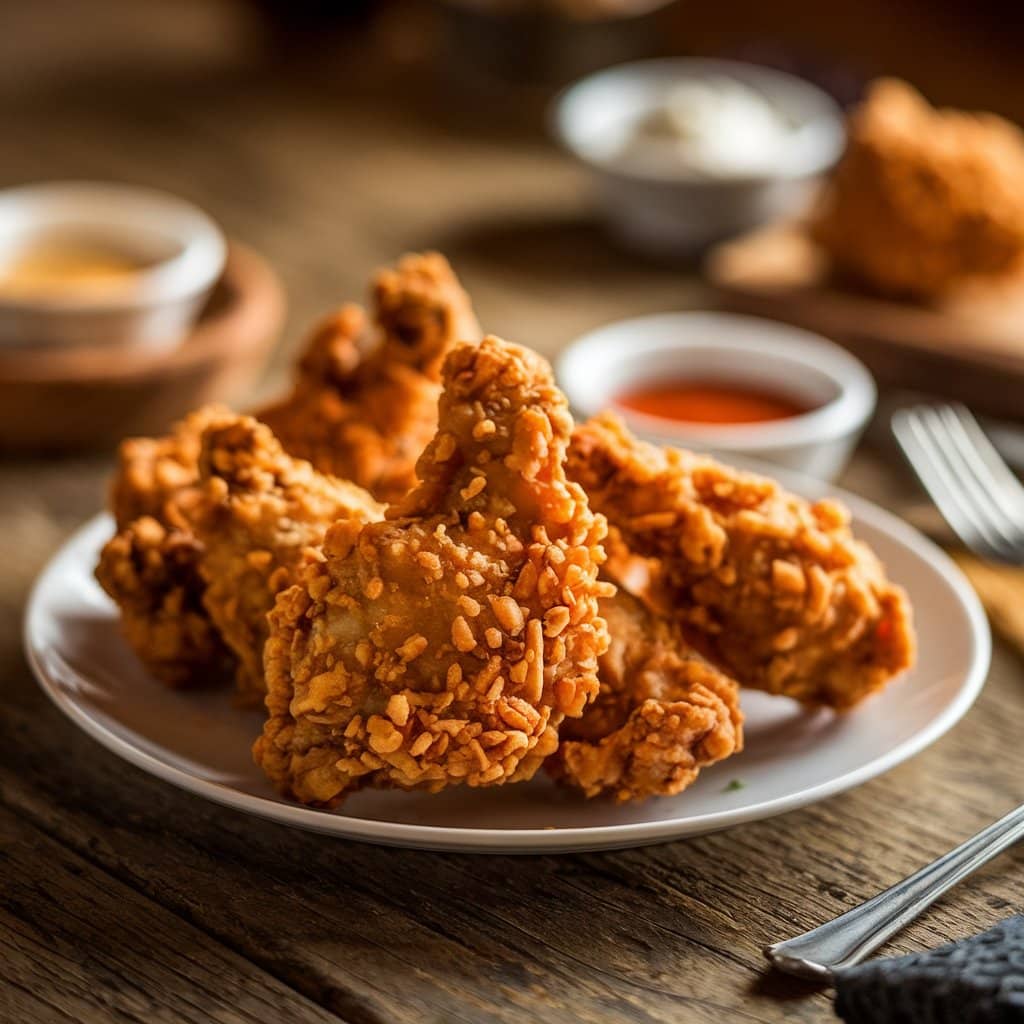Is It Better to Dip Chicken in Egg or Buttermilk? When it comes to preparing crispy, flavorful fried chicken, one key step is dipping the chicken before coating it in flour or breadcrumbs. But which is better for this process: egg or buttermilk? This common kitchen debate has left many home cooks wondering which ingredient creates the best crispy coating. In this article, we’ll explore the properties of both egg and buttermilk, compare their effectiveness, and share expert tips for achieving the ultimate crispy chicken.
Table of contents
Why Is It Important to Dip Chicken in Egg or Buttermilk Before Frying?
The process of dipping chicken before frying is essential for creating a crispy, flavorful crust. This step ensures that the coating adheres firmly, producing a golden-brown, crunchy texture. Here’s why dipping matters and how it improves your chicken:
What Happens When You Dip Chicken in Egg or Buttermilk?
- Adhesion: Dipping chicken provides a sticky surface for the coating (flour, breadcrumbs) to cling to, preventing it from falling off during frying.
- Moisture Lock: Ingredients like egg and buttermilk lock in the chicken’s natural juices, keeping the meat tender and juicy.
- Flavor Enhancement: Dipping agents can add depth of flavor by infusing the chicken with savory seasonings.
The Role of Egg and Buttermilk in Frying Chicken
Single Dip Method
- Chicken is dipped once in a liquid (egg or buttermilk), then coated with flour or breadcrumbs.
- Best for a lighter, less crispy coating.
Double Dip Method
- Chicken is dipped in a liquid, coated in flour, then dipped again and coated a second time.
- Ideal for a thicker, crunchier crust.
Why Dipping Order Matters
- Liquid First: Always dip the chicken in a wet ingredient (egg or buttermilk) first. This creates a moist layer for the dry coating to stick to.
- Coating Second: The chicken is rolled in seasoned flour, breadcrumbs, or cornmeal for a crunchy finish.
Dipping Chicken in Egg for Frying: Pros and Cons
Eggs are a classic choice for dipping chicken before frying. They act as a binding agent, ensuring that the outer coating sticks firmly to the meat. Let’s dive deeper into how eggs work, their benefits, and potential drawbacks when used for frying chicken.
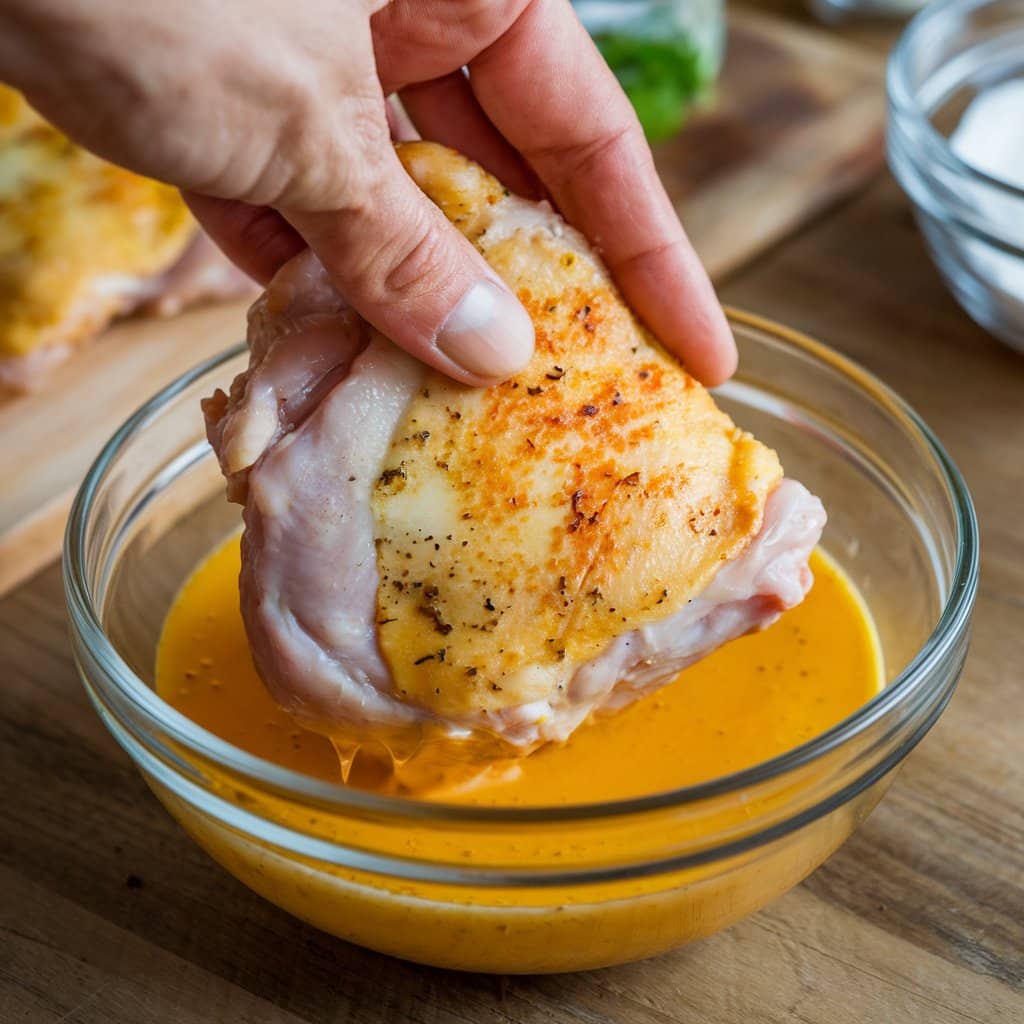
Why Use Egg for Fried Chicken Coating?
Eggs provide several cooking advantages due to their unique properties:
- Binding Power: The protein in eggs acts like glue, helping coatings stick firmly to the chicken.
- Crisping Ability: Eggs create a thick, crispy coating that turns golden brown when fried.
- Flavor Enhancement: Eggs add a rich, savory flavor that complements fried chicken recipes.
How to Properly Dip Chicken in Egg Before Frying
- Preparation:
- Crack eggs into a shallow bowl.
- Whisk until fully blended with a splash of water or milk for a lighter coating.
- Seasoning:
- Add salt, pepper, garlic powder, paprika, or herbs for extra flavor.
- Dipping Process:
- Pat chicken dry to remove excess moisture.
- Dip the chicken pieces into the egg mixture, ensuring even coverage.
- Coat with seasoned flour, breadcrumbs, or a combination of both.
Pros of Using Egg
- Strong Adhesion: Ensures a well-coated, crispy crust.
- Versatility: Works well with various coatings, including flour, breadcrumbs, and crushed crackers.
- Rich Flavor: Adds a subtle savory taste that enhances the chicken.
Cons of Using Egg
- Heavy Coating: Can create a thicker crust, which some people may find too dense.
- Potential Allergens: Not suitable for those with egg allergies.
- Quick Browning: Fries quickly, which can cause burning if the heat is too high.
Using Buttermilk to Dip Chicken Before Frying
Buttermilk is another popular choice for dipping chicken, especially in Southern-style fried chicken recipes. Its tangy flavor, tenderizing properties, and ability to create a light, crispy coating make it a favorite among chefs and home cooks alike.
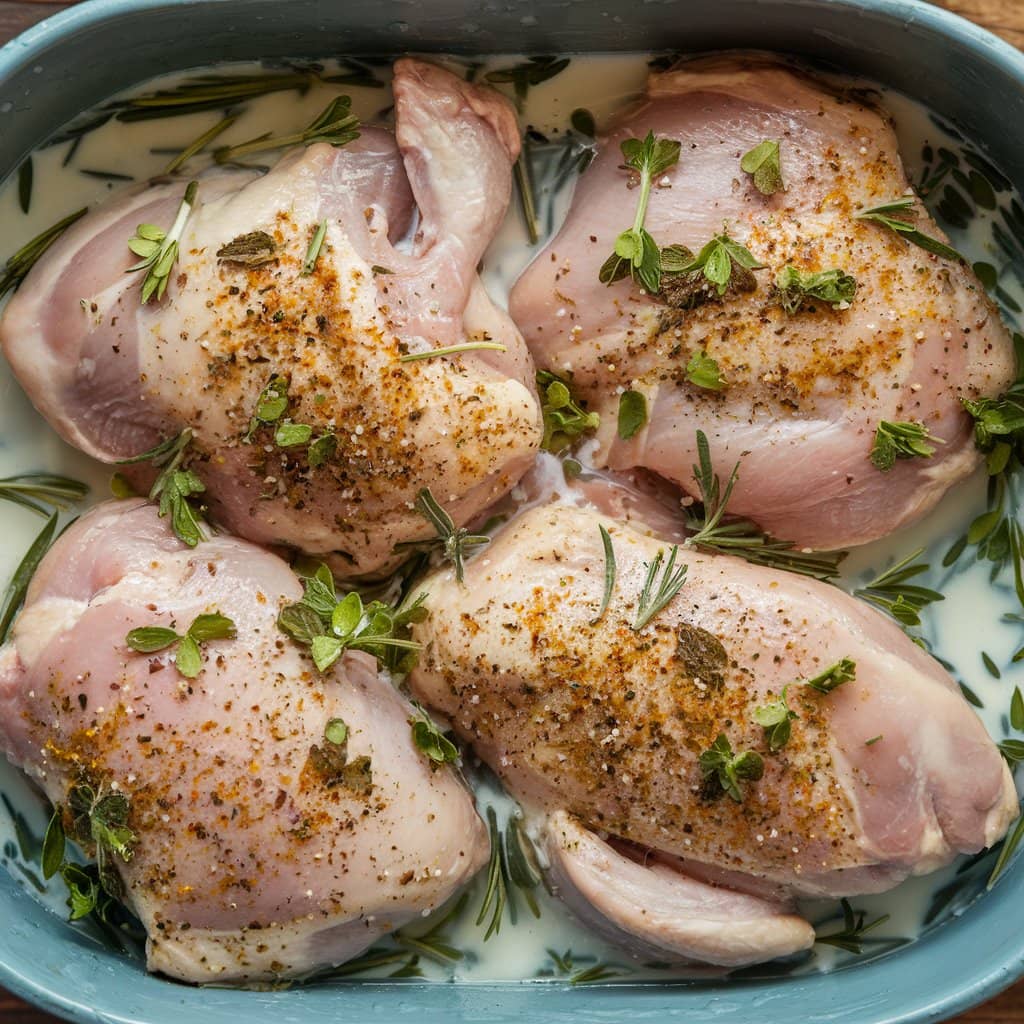
Why Is Buttermilk Good for Chicken Coating?
Buttermilk offers several advantages that set it apart from other dipping agents:
- Tenderizing Power: The acidity in buttermilk breaks down proteins in the chicken, making the meat tender and juicy.
- Flavor Infusion: Buttermilk’s tangy taste enhances the chicken’s overall flavor.
- Light Coating: It creates a lighter, crispier crust compared to eggs.
How to Use Buttermilk for the Perfect Chicken Fry
- Preparation:
- Pour buttermilk into a shallow bowl or dish.
- Add seasonings like salt, pepper, garlic powder, paprika, or hot sauce for extra flavor.
- Marination:
- Place chicken pieces in the buttermilk mixture.
- Marinate for at least 2 hours or overnight for maximum tenderness.
- Dipping Process:
- Remove the chicken from the buttermilk, allowing excess liquid to drip off.
- Coat with seasoned flour, breadcrumbs, or cornmeal before frying.
Pros of Using Buttermilk
- Tender Chicken: Makes the meat moist and flavorful.
- Crispy Coating: Creates a light, flaky crust when combined with flour.
- Easy Seasoning: Absorbs seasonings well, boosting the chicken’s flavor.
Cons of Using Buttermilk
- Time-Consuming: Requires marination, which can be inconvenient for quick meals.
- Mild Adhesion: May not hold coatings as firmly as eggs, resulting in a lighter crust.
- Availability: Not always a staple in every kitchen, unlike eggs.
Egg vs. Buttermilk Comparison
To determine whether it’s better to dip chicken in egg or buttermilk, it’s essential to compare both based on various cooking factors such as texture, flavor, nutritional value, and frying results. This side-by-side analysis will help you decide which dipping method suits your cooking style and desired outcome.
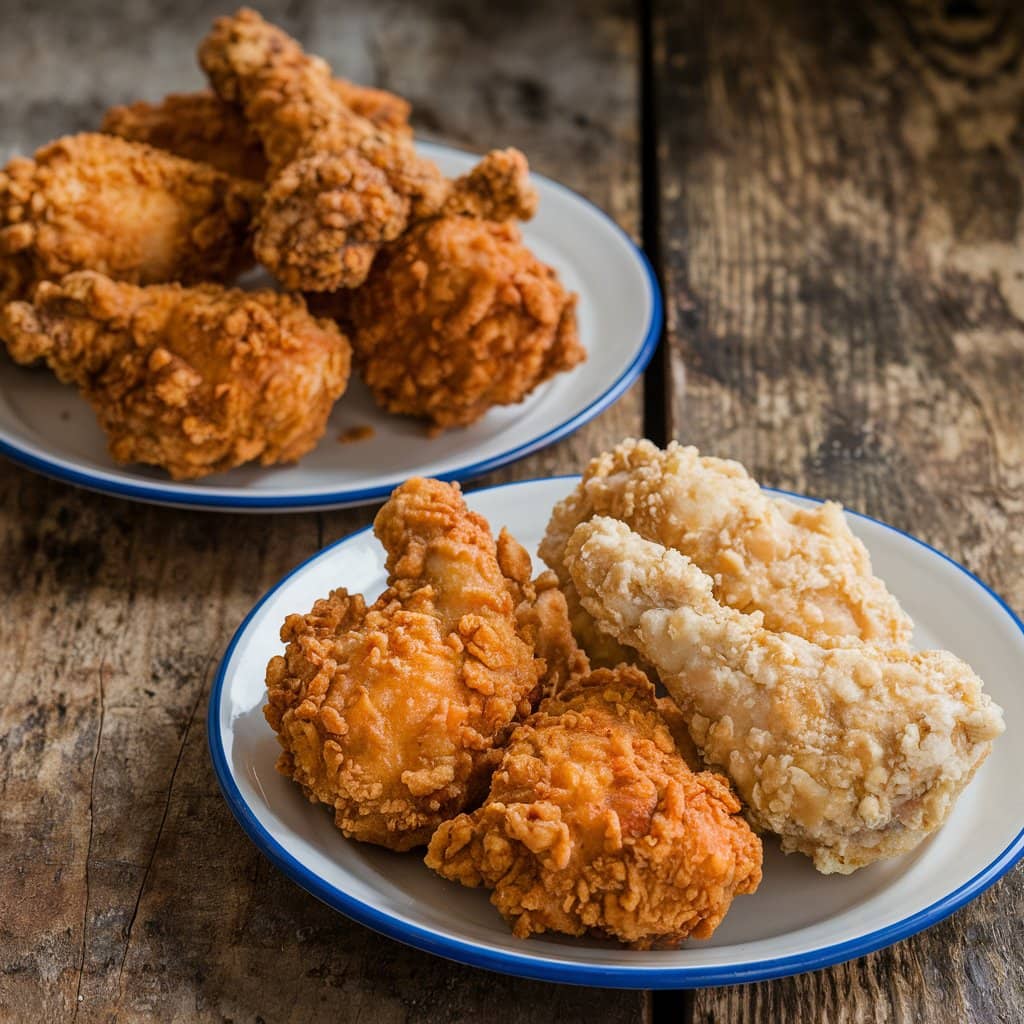
Texture Comparison
Egg-Coated Chicken:
- Crispness: Produces a thick, crispy crust.
- Firmness: Creates a firm, crackly coating that stays intact during frying.
- Best For: Heavily breaded fried chicken and dishes that need a robust crunch.
Buttermilk-Coated Chicken:
- Crispness: Results in a lighter, flakier crust.
- Tenderness: Keeps the chicken incredibly juicy and tender due to its acidic properties.
- Best For: Southern-style fried chicken with a slightly tangy flavor.
Flavor Comparison
Egg-Coated Chicken:
- Flavor Intensity: Mild, with a subtle savory richness.
- Customization: Easily customizable with seasonings like herbs, spices, or even grated cheese added to the egg mixture.
Buttermilk-Coated Chicken:
- Flavor Intensity: Tangy and slightly sour, adding depth to the chicken’s taste.
- Customization: Enhances flavors when combined with hot sauce, garlic, or herbs during marination.
Frying Results
Egg-Coated Chicken:
- Browning Speed: Fries quickly due to egg proteins, requiring close monitoring to avoid burning.
- Oil Absorption: Minimal oil absorption when fried at the correct temperature.
Buttermilk-Coated Chicken:
- Browning Speed: Cooks more evenly and browns gradually.
- Oil Absorption: Can absorb more oil due to its liquid consistency, but still results in a crispy crust if properly coated.
Nutritional Comparison
| Category | Egg Coating | Buttermilk Coating |
|---|---|---|
| Calories | Moderate (70 kcal per egg) | Low to moderate (98 kcal per cup) |
| Protein | High (6g per egg) | Moderate (8g per cup) |
| Fat Content | Contains healthy fats | Low-fat options available |
| Carbohydrates | Very low | Moderate (due to lactose) |
Cooking Scenarios
- Use Egg If: You want a thick, crunchy crust with a rich, savory flavor.
- Use Buttermilk If: You prefer a lighter coating, tender meat, and a tangy finish.
- Use Both If: You want the best of both worlds: dip in buttermilk first for tenderness, then in egg for a strong coating before applying flour or breadcrumbs.
Expert Tips for Perfect Chicken Coating
Achieving the ideal fried chicken coating requires more than just choosing between egg and buttermilk. Proper technique, seasoning, and frying methods can make a significant difference. Here are expert tips for creating the perfect crispy chicken every time.
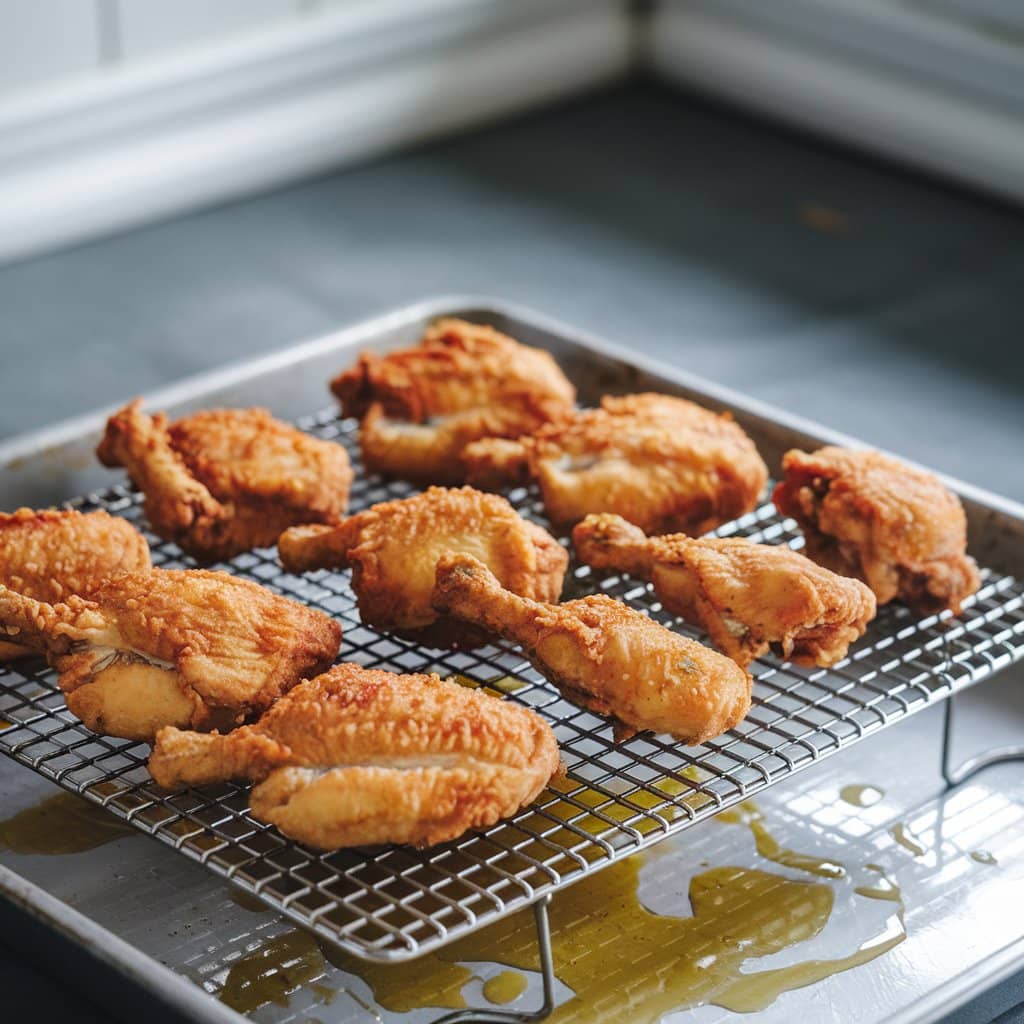
Preparation Tips
1. Use Fresh Chicken:
- Fresh chicken holds coatings better than frozen, ensuring an even crust.
- Pat the chicken dry with paper towels to remove excess moisture.
2. Season Every Layer:
- Season the chicken, the dipping mixture (egg or buttermilk), and the coating (flour or breadcrumbs).
- Consider using salt, pepper, paprika, garlic powder, cayenne pepper, and herbs for bold flavors.
3. Double Dipping for Extra Crispiness:
- For a thicker crust, dip the chicken twice: first in the liquid mixture, then in the coating, and repeat.
- Allow the chicken to rest on a wire rack between dips for better adhesion.
Dipping and Coating Techniques
1. Use Shallow Bowls:
- Use wide, shallow bowls for dipping and coating to avoid messy hands.
- Keep one hand for wet dipping and the other for dry coating to reduce stickiness.
2. Shake Off Excess:
- Gently shake off any extra liquid or coating after each step to prevent a soggy crust.
3. Press the Coating Firmly:
- Press the flour or breadcrumbs firmly onto the chicken for a well-adhered crust.
Frying Tips
1. Preheat the Oil:
- Use oil with a high smoke point like vegetable, canola, or peanut oil.
- Preheat oil to 350-375°F (175-190°C) for optimal frying.
2. Avoid Overcrowding the Pan:
- Fry chicken in batches to prevent lowering the oil temperature, which causes sogginess.
3. Monitor Cooking Time:
- Fry chicken pieces for 12-15 minutes, turning occasionally for even browning.
- Use a meat thermometer to check for an internal temperature of 165°F (74°C).
After Frying Tips
1. Drain Properly:
- Place fried chicken on a wire rack over a baking sheet to allow excess oil to drain.
- Avoid paper towels, which can cause the coating to become soggy.
2. Rest Before Serving:
- Let the chicken rest for 5-10 minutes to lock in moisture and allow the coating to set.
Common Mistakes to Avoid
- Skipping Marination: This leads to dry, less flavorful chicken.
- Not Preheating Oil: Results in uneven frying and greasy chicken.
- Over-Breading: Causes the coating to fall off during frying.
- Frying at Low Heat: Leads to soggy, undercooked chicken.
FAQs About Chicken Coating
Here are answers to common questions about using egg and buttermilk when coating chicken, helping you achieve the perfect fried chicken every time.
1. Can You Use Egg and Buttermilk Together for Chicken?
Yes, combining egg and buttermilk is a popular method. Buttermilk tenderizes the meat while the egg helps the coating stick better. Dip the chicken in buttermilk first, then in a beaten egg mixture before applying the final coating.
2. How Long Should You Marinate Chicken in Buttermilk?
Marinate chicken in buttermilk for at least 2 hours for noticeable tenderness. For best results, marinate overnight (8-12 hours). Avoid exceeding 24 hours, as the meat may become too soft.
3. What Can You Use Instead of Egg for Chicken Coating?
If you’re out of eggs or have an egg allergy, try these substitutes:
- Milk or Buttermilk: Acts as a milder alternative.
- Yogurt: Provides a creamy, tangy coating.
- Plant-Based Milk: Use soy or almond milk mixed with cornstarch for binding.
- Mayonnaise: Adds richness and excellent adhesion.
4. Why Does My Chicken Coating Fall Off?
Common reasons for coating failure include:
- Skipping the Drying Step: Pat chicken dry before dipping.
- Not Pressing the Coating: Ensure the coating is firmly pressed onto the chicken.
- Skipping Resting Time: Let the chicken rest for 10-15 minutes before frying.
- Overcrowding the Pan: Fry in small batches to maintain oil temperature.
5. Which Flour Is Best for Fried Chicken Coating?
All-purpose flour is the most commonly used for fried chicken, creating a crispy, golden crust. For extra crunch, mix in:
- Cornstarch: Makes the coating lighter and crispier.
- Rice Flour: Delivers an ultra-crispy, gluten-free coating.
- Self-Rising Flour: Adds a slight lift and puffiness to the crust.
6. Can You Use Buttermilk Without Eggs?
Yes, buttermilk works well without eggs, especially if you prefer a lighter coating. However, adding eggs can enhance the crust’s thickness and crispiness. If skipping eggs, double-coat the chicken for a more robust crust.
Conclusion
When deciding whether to dip chicken in egg or buttermilk, the answer depends on the result you want to achieve. Eggs provide a strong adhesive for a thick, crispy coating, making them ideal for fried chicken with a crunchy crust. Buttermilk, on the other hand, tenderizes the meat and creates a lighter, flakier coating with a tangy flavor.
For the best of both worlds, many chefs recommend using both: marinate the chicken in buttermilk for tenderness, then dip it in beaten eggs to secure the coating before frying. This method combines the advantages of both ingredients, resulting in juicy, flavorful, and crispy fried chicken.
Ultimately, the choice comes down to personal preference and cooking style. Whether you prefer egg, buttermilk, or a combination of both, following expert tips and proper frying techniques will help you create mouthwatering fried chicken every time.

